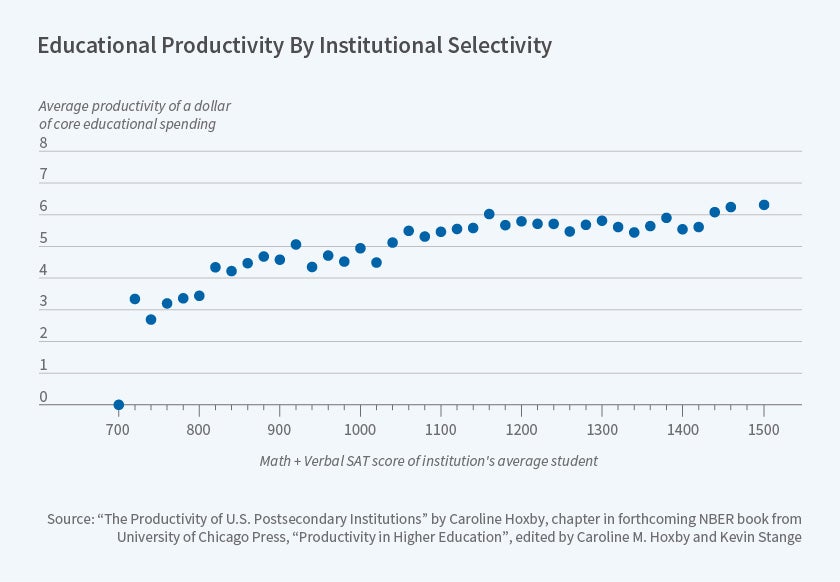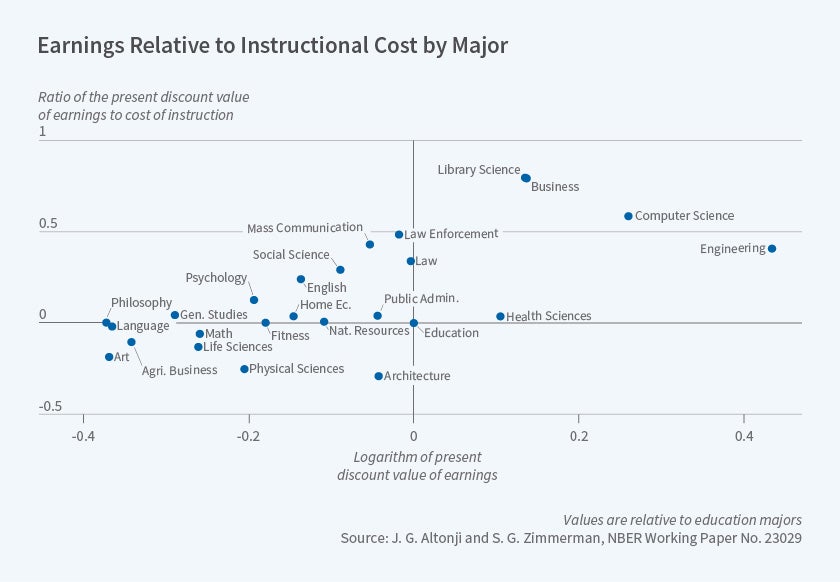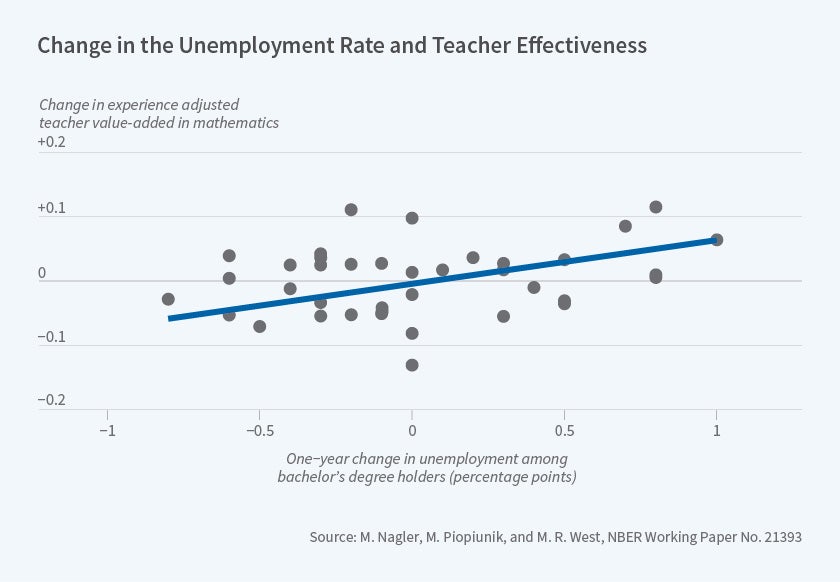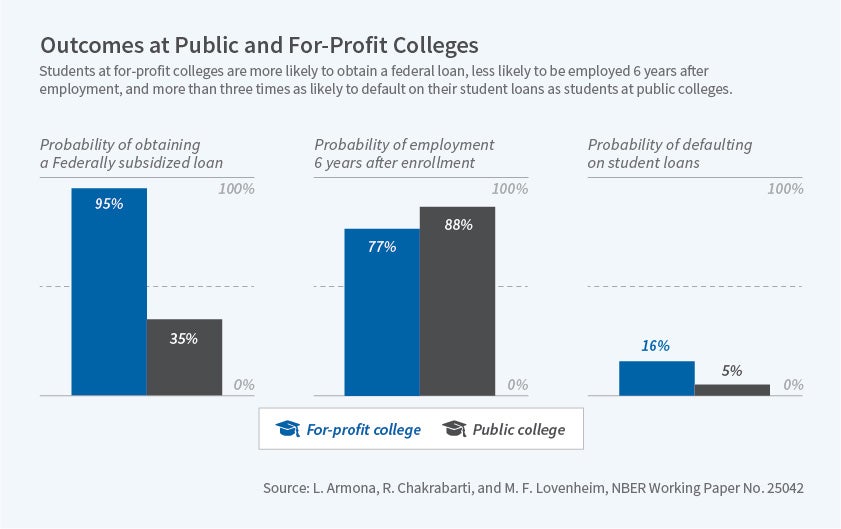Program Report: Economics of Education, 2019
The enterprise of education has a supply side, where institutions produce education, and an investment side, where people acquire education. I say an "investment side" and not a "demand side" because education is largely an investment and not a form of consumption. Because it is an investment, the economics of education is guided by a great deal of theory that would not apply if education were a consumption good like, say, bread. Education economists study both the supply of and investment in education.
On the supply side, we think about institutions' objectives and constraints. We consider competition among institutions and how institutions interact with governments and taxpayers. We use models from public economics, political economy, industrial organization, regulation, and finance.
On the investment side, we consider whether people are under- or over-investing in their own or others' education — a determination primarily based on whether they are earning a higher or lower rate of return than what they could earn in an alternative investment, such as physical capital. We consider market failures because the financing of human capital investments is failure-prone, owing to issues like moral hazard that occur when human beings themselves are the vehicles for investment. We often investigate the potential for market failures due to people being poorly informed or irrational about investing in themselves — mispredicting their returns, say, or discounting the future in a hyperbolic manner.
Applying economic analysis to education is the defining feature of the NBER's Economics of Education Program. As an NBER program, there are also some distinctive features. First, the research carried out by education economists now relies, to an unusual extent, on extremely high-quality administrative data recorded by schools, governments, and authoritative third parties. The data are so accurate and comprehensive that we often can use ambitious econometric tools that are impractical with data that are sample-based, sparse, or prone to error. Second, the program features young scholars to an unusual extent, because in most years the share of education economists in the cohort of new PhDs is greater than the share in the previous year. These emerging scholars are highly productive, and they keep the program in a constant state of rejuvenation and intellectual excitement. Third, the program is unusually diverse and inclusive because education is so interesting to so many scholars. The participants in program meetings represent a wide array of institutions, demographic backgrounds, national origins, and policy views.
This energy and diversity make writing a report like this one a challenge: I cannot possibly do justice to all of the research. So, in this report, I emphasize a few key topics that have received considerable attention in the past few years. In my conclusion, I discuss some up-and-coming topics as well.
Productivity in Higher Education
Our most important project, since my last report, is our initiative to analyze productivity in higher education. Institutions of higher education — from large elite research universities to small private colleges and for-profit institutions — have never been under greater scrutiny. Policymakers, families, philanthropists, and the media question whether the benefits of higher education justify the costs. These questions are fundamentally about the productivity of the sector.
To answer these questions, the NBER, with support from the Alfred P. Sloan Foundation and the Spencer Foundation, commissioned nine papers to be the focus of a conference that brought together researchers, university leaders, policymakers, and journalists. The papers are available as NBER working papers and as chapters in a forthcoming volume, Productivity in Higher Education. The studies use rich and novel administrative data, employ cogent economic reasoning, deploy the latest econometric methods, and evince deep institutional understanding. In combination, the papers are fairly comprehensive: They include studies of the returns to undergraduate education, how costs differ by major, the productivity of for-profit schools, the productivity of various types of instructors, and how online education has affected the market.
Analyses of productivity in higher education must confront significant challenges. Higher education affects many out-comes: students' skills, employment, innovativeness, and public service, to name a few. Higher education institutions conduct a bewildering array of activities across many domains, from undergraduate teaching to medical research. Even if we focus on a single outcome — the earnings-based returns to undergraduate education, for instance — assessing the contribution of an individual institution must overcome the fact that students select into schools based on their aptitude and often attend more than one school. Finally, some benefits of higher education are inherently public in nature and difficult to measure or attribute to any one institution. This project's studies demonstrate that these five challenges — multiple outcomes, the multi-product nature of institutions, selection, attribution, and public benefits — are surmountable.
Figure 1
For example, I attempt to compute the productivity of the vast majority of undergraduate programs (more than 6,000) in the United States.1 While the study emphasizes productivity results based on lifetime earnings because these matter disproportionately for the financial stability of the postsecondary sector, it also shows results based on public service and innovation. The study's most important advance, however, is addressing the aforementioned selection problem by employing all of the possible quasi-experiments in which a student "flips a coin" between schools that have nearly identical selectivity or in which admission staff "flip a coin" between students with nearly identical achievement. Thus, the study exemplifies how having comprehensive data allows one to pursue ambitious econometric strategies.
The study's most important finding, illustrated in Figure 1, is that when earnings are used to measure benefits, the productivity of a dollar is fairly similar across a wide array of selective postsecondary institutions. This result suggests that market forces compel some amount of efficiency among selective institutions. However, I also find that market forces appear to exert little productivity discipline on non-selective schools, possibly because their students are poorly informed investors or rely so greatly on third parties to pay their tuition.
Evan Riehl, Juan Saavedra, and Miguel Urquiola draw upon data from Colombia, a country with a vigorous market for higher education that is not dissimilar to that of the United States. 2 Importantly, Colombian students' learning is assessed by examinations not only before they enter universities but also when they exit. The researchers demonstrate that college productivity based on learning is quite different from productivity based on earnings, especially initial earnings. In particular, learning-based measures are much more correlated with long-term earnings than they are with initial earnings. This suggests that learning reflects long-term value-added, while initial earnings more heavily reflect skills that depreciate quickly or students' pre-college characteristics.
Joseph Altonji and Seth Zimmerman analyze whether productivity differs by college major.3 There are at least three reasons why such analyses are hard. First, there is substantial selection into majors: Students with higher aptitude tend to major in certain fields. Second, the relationship between initial earnings and lifetime earnings varies by major. Engineering majors, for instance, have high initial earnings but subsequently experience unusually slow earnings growth. Third, different majors cost different amounts to produce.
Using administrative data for all Florida public institutions, Altonji and Zimmerman show that majors that are intensive in equipment, space, or highly paid faculty are dramatically more costly on a per-student basis. If we consider costs, the productivity findings are very different than what we might conclude from a naive look at initial earnings. Strikingly, as Figure 2 demonstrates, the ratio of earnings to costs is similar in majors with high earnings and high costs, like engineering, and modest earnings and modest costs, like public administration.
Pieter De Vlieger, Brian Jacob, and Kevin Stange estimate instructor productivity in standardized courses at the University of Phoenix.4 Employing data on more than 300,000 students and 2,000 instructors, they make use of the fact that the assignment of students to teachers is virtually random. They show that instructors' productivity varies greatly and, interestingly, varies much more in person than in online courses. Indeed, if students want to obtain instruction that has maximum value-added, they must get it in person, because the online experience suppresses variation in instructional value-added.
The study's most surprising result, though, is that the University of Phoenix, despite being a for-profit school, pays its highly variant instructors exactly the same amount. This finding suggests that the sort of students who consider non-selective for-profit institutions do not make their enrollment choices based on the schools' record of skill production. If that is the case, the University of Phoenix is probably not forgoing profit by paying all instructors the same amount.
This brings us to a key takeaway from Productivity in Higher Education: Higher education institutions do respond to market forces, but institutions' investors (the students), constraints, production functions, and revenue sources vary. Thus, the extent to which market pressure disciplines productivity differs greatly, with selective institutions probably being subject to much more discipline than non-selective ones.
The Quality of Teachers Is Not Fixed
One of the main results of recent studies using large administrative datasets on educational inputs and outputs in K-12 education is a persuasive body of evidence that, as long assumed, teachers matter. A student who is fortunate enough to have a series of effective teachers can end up with substantially better outcomes, not just in terms of academic achievement but also in terms of college attainment, later earnings, and a variety of social outcomes. But the knowledge that teachers matter could be frustrating if there were no policies by which we could improve the set of people who teach. This is where economics comes in: Do economic logic and evidence suggest that we could have better teachers? This question is one on which research in the last few years has made substantial progress.
Figure 2
Barbara Biasi investigates how teachers responded when a change in Wisconsin law allowed school districts to pay teachers in a flexible way rather than in the rigid, "lockstep" manner based almost entirely on seniority that characterizes nearly all U.S. schools.5 She finds that districts that adopted flexible pay ended up with teachers whose value-added was higher. Part of the improvement arose because young, high value-added teachers, who were systemically underpaid given their productivity, left the rigid-pay districts and joined flexible-pay ones where they could be paid more in proportion to their contributions. The evidence suggests that part of the improvement came through teachers improving their effectiveness in flexible-pay districts, presumably because effective teaching could be rewarded there.
Hugh Macartney, Robert McMillan, and Uros Petronijevic use data from North Carolina to demonstrate that teachers improve their value-added when accountability incentives are strengthened.6 They use rich longitudinal data to separate the improvements into two parts: the part that arises because existing teachers raise their effort, and the part that arises because higher-ability people join teaching or decide not to leave it. The researchers use their estimates to compare the cost-effectiveness of alternative education policies and show that incentive-oriented reforms can outperform policies that only target the recruitment of higher-ability teachers. This is essentially because incentive-oriented policies improve all teachers, including the "stayers," and effectively recruit better teachers.
Sally Hudson attempts to answer the question most often asked about Teach for America (TFA).7 Even if TFA teachers, who come from the nation's most selective colleges, are really much more able than the average incumbent teacher, is it worthwhile to hire them? After all, they are inexperienced, and evidence is strong that instructors improve in their first couple of years. Moreover, TFA teachers need to be replaced every two to three years because the vast majority go on to careers outside the classrooms. Hudson shows that, in fact, hard-to-staff schools appear to benefit from a succession of TFA teachers. This is largely because the TFA teachers' effectiveness is so much greater, even when they are novices, than that of non-TFA teachers. Also, the TFA teachers improve their effectiveness faster than do non-TFA teachers.
Andrew C. Johnston conducts a novel experiment, asking teachers to choose between pay that is more or less merit-based, between systems of merit evaluation, and between compensation that is salary-focused or benefits-focused.8 Much teacher compensation is currently in the form of unusually generous retirement and health benefits. Johnston asks teachers how they would trade off better pay versus students who were easier to teach, students who were lower-income, longer commutes, and so on. Crucially, he conducts these experiments in a district that is actually reconfiguring its entire system of teacher compensation. Thus, nearly all teachers participated in the experiments, and they had strong incentives to answer honestly in order to get the system they preferred. One important result is that teachers with high value-added prefer merit pay more than those with low value-added. This suggests that, by switching to pay that is more merit-based, a district can disproportionately pull in higher value-added recruits. Another interesting result is that, while teachers do need to be paid more to teach students who are low achievers, all else being equal, they do not need to be paid more to teach students from low-income or racial/ethnic minority backgrounds.
Figure 3
Two other papers that demonstrate that greater relative compensation allows schools to recruit more effective teachers are by Markus Nagler, Marc Piopiunik, Martin R. West, and Owen Thompson.9,10 In short, the quality of teachers in the United States is not fixed, but depends on how they are recruited and the compensation-based incentives they face. For example, as Figure 3 illustrates, when the unemployment rate for recent college graduates rises, the quality of teachers, measured by their value added for students, rises.
Fascinatingly, much that can be said of U.S. education can also be said of other countries that might be thought to be very different. For instance, Natalie Bau and Jishnu Das showed that Pakistani teachers' value-added varies about as much as it does in highly industrialized countries, and is, as in those countries, uncorrelated with teachers' credentials.11 As in other countries, teachers in Pakistan improve in their first couple of years, but not much after that. There is no relationship between teacher pay and performance in Pakistan's public schools, where compensation is based almost entirely on seniority, but there is a meaningful positive relationship in private schools, where average pay is lower. These findings apply in many countries, rich and poor. The similarities are so striking that they must reveal something about first, the underlying production function for instruction, and second, the political economy of public education.
Bau and Das' most surprising finding is that, in Pakistan, compensation was so out of line with effectiveness that public schools' actually recruited better teachers after a policy change that put teachers on temporary contracts — jobs more susceptible to performance review — even though that same policy cut their average salaries by 35 percent.
This phenomenon — public school teachers' pay being dramatically out of line with alternative jobs and with effectiveness — is fairly common in developing countries. In Colombia, for instance, Saavedra, Dario Maldonado, Lucrecia Santibanez, and Luis Omar Herrera Prada show that people across all ability levels earn a substantial premium if they teach in public schools rather than take alternative jobs.12 The researchers demonstrate this convincingly by comparing people who barely pass and barely fail the national teacher-screening exam.
Finally, Isaac Mbiti, Karthik Muralidharan, Mauricio Romero, Youdi Schipper, Constantine Manda, and Rakesh Rajani find the intriguing result that teacher pay incentives are more effective when they are combined with additional resources, at least in Tanzania.13 Their findings are based on an ambitious randomized controlled trial involving 350 schools where unconditional grants, teacher incentives, or a combination of both are implemented.
Student Loans
Student loans have risen greatly in volume in recent years and are now by far the largest source of unsecured debt in the United States. Moreover, some students are unlikely to repay, so these loans generate risks for the entire economy in a manner not unlike the risks generated by mortgages in the recent financial crisis. Fortunately, many economists of education associated with the NBER are helping everyone to gain a better understanding of student loans.
For instance, Luis Armona, Rajashri Chakrabarti, and Michael Lovenheim focus on the extremely important role that for-profit institutions play in the non-repayment of student loans.14 These schools' students are very disproportionately responsible for non-repayment because they take on unusually great student debt and experience unusually little improvement in earnings. The researchers ask whether these patterns are causal. In other words, if the same students were to attend, say, public community colleges, would they end up with equal payment problems? By comparing enrollment and postsecondary outcome changes across areas that experience similar labor demand shocks but have different supplies of for-profit institutions, they are able to show that much of the effect is indeed causal. As Figure 4 shows, enrollment in for-profits leads to greater loans, increased non-repayment, and worse labor market outcomes.
Figure 4
Why might enrolling at a for-profit cause greater debt and non-repayment? Charlie Eaton, Sabrina Howell, and Constantine Yannelis answer this question.15 Studying what happens when a for-profit college is subject to stronger incentives to maximize profits as the result of a private equity buyout, they find that institutions subject to high-powered profit-maximizing incentives intensify their focus on capturing federal government aid at the expense of student outcomes. It is worth noting that federal loans, federal aid, and veterans' GI Bill-based aid often make up close to 100 percent of the revenue at for-profit schools. In other words, a student paying tuition from his or her own pocket is a rare exception, not the rule, at such schools. The researchers find that, when their incentives to maximize profits are intensified, for-profit schools enroll more students, enroll students who are less likely to benefit from higher education, increase tuition, and increase student loans. The results are worse student outcomes in terms of graduation rates, employment, and earnings, and significantly lower repayment rates.
Other evidence of for-profit institutions' eagerness to capture government aid comes from Matthew Baird, Mike Kofoed, Trey Miller, and Jennie Wenger.16 They show that for-profit schools quickly raised tuition to absorb the increases in maximum tuition allowed under the new Forever GI Bill. Given the high tendency of veterans to attend for-profits, the bill thus improved profits but did little for veterans. Arguably, this bill made matters worse for non-veterans who attend for-profit schools, since they too were faced with somewhat higher tuition and, consequently, greater loans.
What would happen if for-profit colleges were to lose some of their access to federal loans and other federal financial aid? Stephanie Cellini, Rajeev Darolia, and Lesley Turner examine what happened when, in the 1990s, students at more than 1,200 for-profit institutions faced restricted access to loans because loan default rates were so high at the schools.17 Using variation in the timing and restrictiveness of sanctions, the researchers find that low-income students were less likely to attend for-profit schools but were so much more likely to attend public community colleges that the effects on their enrollment were about a wash. The effects on loan repayment were positive, however, because the students who went to community colleges acquired less debt and were more likely to repay the smaller loans they took on.
Other Exciting Developments
The program is proud to report that a long-time member, Parag Pathak, won the American Economic Association's John Bates Clark Medal in 2018. The award citation recognized his work using market design theory to analyze systems in which students are matched to schools. Such systems are used in numerous cities. In a study of Taiwan's matching system, for example, Umut M. Dur, Fei Song, Pathak, and Tayfun Sönmez found that school assignment mechanisms which include deduction systems are manipulable, meaning that children from families which are strategic are more likely to receive desirable placements.18
As mentioned at the outset, there is much more exciting research associated with the Economics of Education Program than I can possibly describe here. To induce you to explore further, let me mention just a few topics that are "up and coming." A number of recent NBER working papers and conference papers evaluate online education, both at the K-12 and college level. The use of technology in education has also been the subject of recent studies which explore both developed and developing countries. Some evidence from India looks promising.
There is new evidence on the returns to college majors, calling into question the common impression that the greatest returns are to becoming an engineer. Supported by rich data and the econometric ambitiousness of program members, many program meetings now include presentations on applied econometric methods. Indeed, we now host methods symposia. Increasingly, advances from behavioral economics, brain science, and psychology are finding their way into papers in the economics of education.
Endnotes
C. Hoxby, "Estimating the Productivity of U.S. Postsecondary Institutions," July 2018, chapter in forth-coming book, C. Hoxby and K. Stange, eds. , Productivity in Higher Education, University of Chicago Press.
E. Riehl, J. Saavedra, and M. Urquiola, "Learning and Earning: An Approximation to College Value Added in Two Dimensions," chapter in forthcoming book, C. Hoxby and K. Stange, eds., Productivity in Higher Education, University of Chicago Press.
J. Altonji and S. Zimmerman, "The Costs and Net Returns to College Major," NBER Working Paper No. 23029, January 2017.
P. De Vlieger, B. Jacob, and K. Stange, "Measuring Instructor Effectiveness in Higher Education," NBER Working Paper No. 22998, December 2016.
B. Biasi, "The Labor Market for Teachers under Different Pay Schemes," NBER Working Paper No. 24813, July 2018.
H. Macartney, R. McMillan, and U. Petronijevic, "Teacher Performance and Accountability Incentives," NBER Working Paper No. 24747, June 2018.
S. Hudson, "The Dynamic Effects of Teach for America in Hard-to-Staff Schools," NBER Summer Institute, 2017.
A. Johnston, "Teacher Utility, Separating Equilibria, and Optimal Compensation: Evidence from a Discrete-Choice Experiment," Fall 2018 Economics of Education Program.
M. Nagler, M. Piopiunik, and M. West, "Weak Markets, Strong Teachers: Recession at Career Start and Teacher Effectiveness," NBER Working Paper No. 21393, July 2015.
O. Thompson, "School Desegregation and Black Teacher Employment," NBER Summer Institute, 2018.
N. Bau and J. Das, "The Misallocation of Pay and Productivity in the Public Sector: Evidence from the Labor Market for Teachers," NBER Spring 2017 Program.
J. Saavedra, D. Maldonado, L. Santibanez, and L. Herrera Prada, "Premium or Penalty? Labor Market Returns to Novice Public Sector Teachers," NBER Working Paper No. 24012, November 2017.
I. Mbiti, K. Muralidharan, M. Romero, Y. Schipper, C. Manda, and R. Rajani, "Inputs, Incentives, and Complementarities in Education: Experimental Evidence from Tanzania," NBER Working Paper No. 24876, July 2018.
L. Armona, R. Chakrabarti, and M. Lovenheim, "How Does For-Profit College Attendance Affect Student Loans, Defaults, and Labor Market Outcomes?" NBER Working Paper No. 25042, September 2018.
C. Eaton, S. Howell, and C. Yannelis, "When Investor Incentives and Consumer Interests Diverge: Private Equity in Higher Education," NBER Working Paper No. 24976, August 2018.
M. Baird, M. Kofoed, T. Miller, and J. Wenger, "For-Profit Higher Education Responsiveness to Price Shocks: An Investigation of Changes in Post-9/11 GI Bill Allowed Maximum Tuitions," NBER Fall 2018 Program.
S. Cellini, R. Darolia, and L. Turner, "Where Do Students Go when For-Profit Colleges Lose Federal Aid?" NBER Working Paper No. 22967, December 2016.
U. M. Dur, P. Pathak, F. Song, and Tayfun Sönmez, "Deduction Dilemmas: The Taiwan Assignment Mechanism," NBER Working Paper No. 25024, September 2018.






